|
I have been gathering ideas for a Sharp Practice scenario of the last moments of Prince Józef Poniatowski, Commander in Chief of the army of the Duchy of Warsaw, who died on the last day of the battle of Leipzig in October 1813. I found two accounts in Polish, one by Mariusz Lukasiewicz in his book “Armia Ksiecia Jozefa, 1813” and the other in “Lipsk”, by Jadwiga Nadzieja. Both accounts drew on eye witness reports and are almost identical. The following is a translation of the account in Lukasiewicz, with a small comment from Nadzieja’s book. Introduction: On 19 October 1813, Napoleon’s army was retreating westwards from Leipzig, covered by a rearguard including Poniatowski’s Polish VIII Corps. The army had only one route out of the city and while the details are still disputed, the single bridge over which the troops were retreating was blown up prematurely, leaving several thousand troops of the rearguard on the far side, including the Poles. With the bridge gone, the only way the stranded troops could avoid death or capture was to cross two rivers, the Pleisse and then the Elster, either on makeshift bridges or by swimming. Meanwhile, Russian and Prussian skirmishers were racing to cut them off. “Poniatowski retreated from the water fountain, together with his headquarters staff and remaining soldiers. They moved through the Reichel‘s garden and the Rudolf garden towards the river Pleisse under fire from approaching enemy skirmishers. The cuirassiers and some chasseurs were still fighting. General Bronikowski strongly urged the commander-in-chief to swim his horse across the Pleisse. Poniatowski was reluctant to withdraw, but eventually ordered his escort to gain time with one more charge and then jumped into the river. The Pleisse was deep and fast moving due to the autumn rains and Poniatowski’s horse couldn’t make it up the far bank. Seeing him in trouble Hypolite Blechamps, a young French captain on the Headquarters staff, ran to help. (Jadwiga Nadzieja says he was assisted by another aide, Ludwig Kicki, who was shot soon after dragging Poniatowski to the bank). He freed Poniatowski from his horse and pulled him onto the riverbank. The prince now proceeded for a time on foot. As he retreated through the gardens he was wounded for a fourth time, this time by a musket ball in his side. The wound was serious and only quick attention stopped him from bleeding to death. Poniatowski fell unconscious into the arms of his escort but soon regained his senses. His staff begged him to hand over command to one of his generals and surrender to the Allies so his wounds could be properly treated. Now half-conscious, Poniatowski refused, saying that his honour and duty to his Fatherland would not permit him to do this. With the help of his adjutants, he mounted another horse and supported from both sides, rode along the River Elster towards a crossing place that had been indicated by an officer of engineers. Allied troops had by now already reached the river and some had even crossed to the other side, shooting at the soldiers as they tried to swim to safety. Bleeding heavily and losing consciousness every few moments Poniatowski’s path was suddenly blocked by an enemy detachment and he turned his horse and jumped in the river. The horse managed with difficulty to reach the far bank, but as it scrambled to get out of the water, Poniatowski was hit again by a musket ball. He slid off the horse into the water and began to drown. Captain Blechamps again jumped in to help him, but soon they both disappeared in the current and neither was seen alive again. Poniatowski’s corpse was recovered from the Elster by a local fisherman on 24 October and his identity confirmed by Polish prisoners.”
0 Comments
Two refights and a post-mortemI have recently hosted two games set in Eastern Europe, using For King and Parliament (FKaP) by Simon Miller and Anthony Brentnall. In both games we fought the historical scenario for the Battle of Lubar, which is on the 17th Century scenarios page here. Background to the battle of LubarThe battle of Lubar (or Lyubar) was fought between a Muscovite-Cossack army and a Polish-Tatar force. It was the first engagement in the 1660 Ukrainian campaign, which took place during the Thirteen Years War between Muscovy and the Polish-Lithuanian Commonwealth. Lubar was actually an engagement over many days, most of which consisted of minor actions during an extended blockade. The action on 16 September 1660 was the only occasion when the full complement of both armies went toe to toe. We have played games based on Lubar several times in the past few years, first using Warlord Games’ Pike and Shotte, once with Maurice, then with Tercios by el Kraken and now using FKaP. All of them were interesting games but for my taste, FKaP gave the most satisfying game. Each of the rules we have used so far required a little tweaking to cover the troop types present at Lubar. The one set that we could have played without any amendment is ‘With Fire and Sword/Ogniem i Mieczem’ by Polish company, Wargamer. These rules and the fantastic figures and terrain released for them have opened up this period to non-Polish gamers and I have hundreds of their figures in my collection. The only thing is, I cannot get on with the rules themselves. As the saying goes, I am sure it’s not Them, it’s Me. A couple of weeks ago, Wargamer announced that they are to replace With Fire and Sword with a quite different version. I will pick these up and perhaps WFaS Reloaded will hit the spot. Adapting FKaP to Eastern Europe17th century warfare in Eastern Europe had more in common with the West European experience than some might presume, especially as the century progressed. So the bones of FKaP work very well as they stand. There were however some troop types, weapons and tactics that were unknown in the West and I wrote a small set of rule adaptations to cover them. Most of these were rules brought forward from Simon Miller’s Ancients rules, To the Strongest, so fitted in comfortably. I’ve adjusted them a few times after playtesting and the current version is on the scenarios page here. Lubar refight: Take 1Earlier this month I hosted the first refight, with Chris playing Muscovy and Paul leading the Poles and Tatars. Chris deployed his Cossacks in his main camp with a regiment in the forward trench on his right. He put Muscovite infantry with light guns in the redoubt on the left, with some cavalry behind them. The rest of the cavalry joined the infantry in his main camp. Paul placed his foot and artillery in his centre, with his cavalry divided between Potocki on the right and Lubomirski on the left. Paul left space on the left for his Tatar Allies to arrive (-and leave: the scenario makes their presence unreliable at best). The battle began with a spirited assault by the Tatars on the Cossack trenches, while the Polish infantry advanced on the hilltop redoubt. Chris responded to the hilltop assault by sending cavalry around the eastern side of the hill to threaten the Polish flank. Paul challenged this assault with pancerni and a unit of hussars, which blotted its copybook early on by failing to activate to charge, drawing the dreaded two 1s in succession. Paul was admirably calm about this and the hussars redeemed themselves on their next activation, smacking up some Muscovite Reiters and blocking Chris’ outflanking attempt. On the left the Tatar command steadily drained away, as units left the field in search of easier plunder, but not before they had caused impressive damage to the Cossacks in the trenches. Paul even managed to break into the main enemy camp, if only temporarily. The game ended with Chris handing over his last victory medal but he was still well established in his main camp and as Paul’s medals were also running low, we agreed this was more a winning draw than a walkover. In our after-action discussion, we agreed the game’s outcome was remarkably similar to the history: the Poles and Tatars had the advantage in the open with their superior cavalry, while the Muscovite and Cossack infantry were a tough challenge for the outnumbered Polish foot to beat. Both players attacked the scenario with gusto and picked up the rules easily. Refight Take 2After the first game I adjusted two aspects of the scenario. First, I moved the Muscovite camp one square westwards to make the land around the Muscovite hill more open to a flanking manoeuvre. I also changed the scenario special rules for the Tatar forces to make them last a little longer on the table. Game 2 saw Rupert’s Muscovites and Cossacks facing Kevin’s Poles and Tatars. Both sides deployed rather differently from the players in game 1. Rupert put his infantry in the hilltop redoubt, the trenches in the forest and his main camp, then deployed his cavalry in a line in front of the camp. He placed his field artillery in the trenches, initially facing forward but later rotating to enfilade the advancing Poles. Kevin drew up with his cavalry commands on the left and centre and his infantry on the right, facing the hilltop redoubt. On his first turn Kevin started an outflanking attempt with two infantry units and some dragoons, aiming to get around the eastern end of the Muscovite redoubt. Unfortunately, this manoeuvre was plagued by poor activation attempts throughout the day and by game’s end was still slogging up the table, without ever coming to grips. At the same time the Polish foot in front of the hilltop redoubt spent the day waiting for the outflanking force to get into position and so the entire Polish infantry complement was basically uncommitted throughout the game. The Polish cavalry and the Tatars, by contrast, were heavily engaged from the start. The Muscovite cavalry launched a spoiling attack as the enemy advanced, which considerably disrupted the Polish front line. However this attack then exposed the Muscovite horse, now variously out of pistols or spears and low on dash, to the still-fresh Polish second and third lines. The result was to be expected and in one turn, several Muscovite victory medals were handed over to the enemy. But with the Muscovite and Cossack infantry in the main camp now able to fire on the enemy cavalry, the balance of damage was nearly restored. It was clear that the Polish cavalry would not make headway against the entrenched Muscovite and Cossack foot and, with real time running low, we agreed that the Poles would not press home their attack and the battle ended. This was an interesting game, in which the deployment of both sides was unexpected. The Poles, already outnumbered in infantry, effectively left their Foot out of the battle by stacking them on their right and attempting the outflanking manoeuvre. Even if they had had more success with activation draws, the Polish ‘right hook’ would still have spent a lot of time getting into position before engaging. Kevin commented that if he had assigned the task to cavalry, the result could have been very different. On the other side, the screen of Muscovite cavalry across the centre delayed the Polish advance, but it was both outnumbered and outclassed by the cavalry facing it and it blocked the fire of its own infantry behind it. Once that infantry was given a free field of fire the prospects for the Polish horse became less rosy. Perhaps the Muscovite Horse could have withdrawn sooner once it inflicted the first reverse? All of this is easy for me to say, but I wasn’t playing the game. Both players showed considerable aggression and the cavalry confrontation in the centre was particularly hard-fought. Kevin certainly made the most of his flakey Tatar units, which did stay on table for longer than in the first game but were still sloping off the field at inconvenient moments. The game versus history: how credible were the results?I was frankly delighted by the way FKaP played out in both games. On a general level, the results were reassuringly similar to what happened in history, especially in the first game. The way cavalry performs is particularly satisfying. The clash between the Muscovite and Polish horse in the second game felt just right: the Muscovites were slightly, but not hopelessly outclassed in the initial combats but the Poles had the advantage of fresh units ready to challenge the increasingly tired Russians. As the saying goes, numbers have a quality all of their own.. The Tatars also behaved as I would expect. They are primarily a nuisance and with only one hit are brittle, but they can be devastating against an enemy that is already disordered and tired. Also, their sheer numbers can help them to overwhelm a superior opponent. The evade rule, adapted from To the Strongest, works fine. As for the infantry, pike and shot are suitably ponderous while the smaller Haiduk and Streltsi units are a little easier to move. Finally, artillery can occasionally do damage but isn’t a battle winner, which is appropriate for this period. In short, I think after these games that the Eastern Europe adaptations for FKaP are about right. Earthworks were an important feature of the battle of Lubar and I was impressed by the way they work in FKaP. Based on accounts of battles in this period, they should give an advantage to troops defending them but ought not to be impregnable: during the battle of Lubar, attackers did break in, both to the hilltop position and the main Cossack/Muscovite camp. I am increasingly impressed by FKaP: these rules are easy to learn and deceptively straightforward. New players pick up the mechanics very quickly but they face multiple choices and challenges each turn. The next battle I’d like to try is Polonka (great name!), the battle between Muscovites and Lithuanians fought earlier in the same year of 1660. This was an encounter battle without prepared positions and I’ll be interested to see how it plays with these rules. Figures and game aidsThe figures in our games were 15mm by Wargamer, Essex Miniatures, Lancashire Games (both from today and the 1980s) and a superb Spanish producer who had a stand at Salute some years ago, but whose figures I haven’t seen again. The game mat is by Deep Cut Studios, bought from Simon Miller’s Big Red Bat Shop. We used Simon’s ‘chits of war’ for activations, also available from his shop, and used ten-sided dice to resolve combats.
Last month Chris and I played a game of Lasalle 2, the tactical Napoleonic game by Sam Mustafa of Honour Games. Chris was new to the rules and picked them up very quickly. We replayed the Markkleeberg 1813 scenario that I had first tried on Spencer and Dan, described here. After the first game of Markkleeberg I had changed the victory conditions by removing the sudden death victory provision, which allows a player to win by ignoring geographical objectives and simply killing enough enemy units. In our first game Spencer had bunched all his forces into his right wing and tried to overwhelm Dan’s left, while leaving Markkleeberg with its objective marker alone. A valid approach in a stand-alone game (and it nearly succeeded) but it meant the battle played out very differently from the actual events of 1813. With sudden death removed, victory now depends on who holds real estate in two locations: the village on the Polish right and the hill in their centre. I also modified the arrival of some Prussian reinforcements, after rereading the sources and producing a ‘best guess’ sequence of events drawn from the five different accounts that I have of the action. The current version of the scenario is here. I am happy with these tweaks as the game with Chris played out more closely to the actual battle. My Prussians tried and failed to kick Chris’s Polish garrison out of Markkleeberg while the Russians attacked the central hill. To cut a long story short, after a bitter struggle the Russians briefly reached the objective on the hill but couldn’t consolidate their hold and the Poles retook it in the final turn. Victory therefore went to Chris, with my troops back near their starting positions in the valley. The game moved quickly and we both enjoyed the rules. The fluid turn sequence keeps both sides fully involved and presents the players with tricky choices about how to use their scarce momentum points. There was only one incident when our experience of ‘conventional’ rules made us question whether what happened was right. Namely, a regiment of cavalry charged and overthrew an enemy battery, without that battery being able to fire canister as the cavalry closed. This did feel tough on the guns but chewing it over afterwards, I concluded the issue was of our perception rather than a failing in the rules. In most circumstances, Lasalle would allow a battery facing cavalry to its front the chance to fire before that cavalry charged. It just happened in our game that the battery had already fired at a different target earlier in the same turn, so it is plausible that the cavalry could have closed while the battery was reloading. Also, even without firing, there was a slim chance that the battery could have won the combat against the charging cavalry, which, had this happened, might have been rationalised as the gunners successfully loading and firing canister in the nick of time. Try these rules! It’s interesting to see how fashions in wargame rules evolve. When I started playing Napoleonics in 1974 or thereabouts, the fashion was for simultaneous turns, highly differentiated national characteristics, detailed casualty calculations, quirky game aids (anybody remember the bounce stick??) and almost no command friction. In recent years there has been a shift to IGO-UGO turn sequences, more abstraction of the mechanics of combat, and greater focus on the options and limitations placed on command control. All welcome developments as far as I can see. The combination of MO points and totally fluid turn sequence in Lasalle 2 takes us into yet new territory. This approach may sound odd to some, but I would urge every Napoleonic gamer to give it a try. I suspect that with Lasalle 2, Sam Mustafa has set a new standard for tactical Napoleonic games that other rules writers will be emulating for some time to come.
I have been asked if I would upload the player briefings that we used for the Shenandoah Campaign that we played twice during the Spring and summer lockdown. I have added these at American Civil War scenarios.
In November we started another campaign, based on the activities of a unit of French Maquis in the run-up to D Day. As we are still unable to meet up, I tried to make this more of a narrative story, without the tabletop encounters that feature in most wargame campaigns. Inspiration for the storylines came from the excellent book, "Forgotten Voices of the Secret War". The spirit of the game is intended to be a little tongue in cheek and neither side is allowed to contemplate atrocities. Not as silly as the UK TV comedy 'Allo, 'Allo but not far off. The campaign started well, with a clever German player intercepting an arms drop in the first phase. One maquis player kidnapped a collaborationist mayor's dog (Fritzy), which became the new mascot of his group. A group of escaped Allied airmen was spirited out of the region under the noses of the Germans and a radio interception unit was shot up in an ambush. After the chance discovery of an arms cache, the Germans laid a trap which wiped out a maquis section. So far, so satisfying. Unfortunately real life then intervened and I had to suspend the campaign, as my father had fallen seriously ill. The players were very understanding. Sadly, my dad passed away shortly before Christmas and there is a lot of administration associated with his estate. I am not sure when I will have the head space to get back to the campaign and when I do, the players may decide that the moment has passed. I would quite understand. But the exercise has been fun and if this game is abandoned, I'd like to try again in a few months. The map and campaign rules are at WW2 Maquis campaign. When the lockdown began, a few jokes did the rounds that wargamers would barely notice the difference since we already spend so much time alone with our hobby. Of course, the same joke has been applied to online gaming, model railways, stamp collecting and other indoor pass times. And to some extent, I do think those of us with hobbies like these might have had some advantages compared to people whose leisure involves, say, team sports or ballroom dancing. But the past few months have brought home to me that interacting with other gamers is central both to my enjoyment of wargaming and to my motivation. It has been a challenge to make up for the absence of face to face gaming.
Although we haven’t met to play since mid-March, I have found our little wargaming WhatsApp group to be a source of entertainment and solace over the past several months. We range in age from mid 20s to 60 and have diverse interests but I greatly enjoy our chats and following other gamers’ projects. Our first attempt to fill the gaming void was a play-by-email ACW campaign. Players supplied their instructions each turn and I resolved the moves on a master map. I played out larger battles solo, using plans submitted by the players, and worked out lesser encounters with a simple combat results table combined with some free kriegspiel. The most fun for me was inventing a bit of incidental narrative, such as the nighttime escapade of a federal cavalry unit passing through rebel lines, aided by a local school mistress who supported the union cause. This incident had very little impact on the big picture but added some flavour to my next report to General Frémont. I ran the ACW campaign with two groups of players and I think it went quite well. I hope the players enjoyed it too: I was given a rather fine bottle of Black Dog gin by one group after their campaign ended. I wish I could have played more socially distanced games once the lockdown eased but have only managed one, with my son Nick, which was a knockabout ‘Middlehammer’ game between Orcs and Empire. I suspect our choice of an old Games Workshop System was influenced in part by the desire to play a familiar game from happier days. Or is that a bit deep I wonder? For the rest of my hobby time I’ve been rebasing old figures, painting models that I’ve had for years and writing scenarios for when face to face gaming comes back. I’ve also ordered my first 15mm Napoleonics for at least twenty years, mostly in the form of gun limbers but also an entirely new army: I’ve always loved Bavarian uniforms and am delighted to have added them to my collection. This afternoon new measures were announced by Boris Johnson to tackle the resurgence of Covid cases in the UK. Maybe it’s time I started looking at another email campaign... Our second Valley Campaign of lockdown ended today, with victory for Stonewall Jackson and Baldy Ewell. This campaign lasted for ten turns (taking about that number of weeks) and ended with a decisive victory for the rebels. I’m glad to report that all four players put their all into the campaign, right up to the final turn. Below, I am recording the Richmond Times report that went to the players today. Afterwards, I have supplied a post campaign analysis, again shared with the players. Gentlemen This is a different form of report from previously as you are all receiving the same document. The campaign has ended with a victory for the Confederacy. Jackson and Ewell are in possession of Winchester. Banks is at Charlestown and Frémont at Martinburg, excepting a force at Wardensville. The Federals have lost a great many men and materiel and are not in a position to continue the fight for now. The last turn proved decisive. I pass on the following report, some of it eye witness, by Monty Breeches, a correspondent of the Richmond Times, travelling with General Jackson. “The past few days have seen a dramatic series of events, the consequence of which has seen the retirement of Union forces towards the Potomac. It began a while back with a reconnaissance ordered by General Jackson, to explore the passes into the valley from the Allegheny mountains. His cavalry reported that the road to Winchester across Cacopon River Crossing had been left unguarded. Jackson responded immediately, summoning all available troops to follow this route into the heart of Federal territory. The Federal commanders, Frémont and Banks, reacted to this movement by pulling back their forces from further up* the Valley, but Jackson got the drop on his opponents and, after some struggle, took Winchester from Banks, in so doing dividing the latter’s Command. Meanwhile General Ewell followed the Federals northwards, keeping in close touch with their outposts. The final stage in the campaign began with Jackson established in Winchester with almost his entire command; Banks divided between Charlestown and Middleton; Frémont between Strasburg and Wardensville; and Ewell between Front Royal and Mount Jackson. Banks and Frémont agreed that their top priority must be to regain Winchester and so reopen communications with Harper’s Ferry. To do this, Frémont would recall his forces from Wardensville and march northwards down* the Valley Pike. Banks would wait for his approach and then the two would attack Winchester simultaneously from Kernstown, Middleton and Charlestown. This plan, however, depended for success upon the inactivity, or at least sluggishness, of General Ewell. A dangerous calculation indeed! For General Ewell, aware also that a crucial challenge had arrived, chose this moment to unleash a bold assault on Strasburg from the South and East. In one of those occasions when bad luck bites the bottom of the bold, Frémont, in his haste to move north, marched out of the entrenchments at Strasburg before his troops in Wardensville reached the town, leaving the defences unoccupied. At just this moment, Ewell’s cavalry, reinforced by half of Jackson’s cavalry, arrived in the town, followed closely by hard marching infantry. Frémont, who by chance was riding through en route from Wardensville, ordered his accompanying cavalry to restabilise the situation while his infantry forged ahead to Winchester. It was a brave decision not to recall any infantry from the march. Alas for Frémont, his cavalry although it fought bravely, could not stem the confederate tide. Ewell’s troopers smashed through the federal horse. Ewell detailed some troops to hold Strasburg against the Wardensville road and, fully aware of the need for haste, spurred his main body onwards down the pike. With Ewell coming up fast behind him, Frémont was forced to turn his forces around or face being taken from behind while on the march. The messy running fight that ensued favoured Ewell, whose cavalry was superior in both numbers and quality. Try as Frémont might to send at least one brigade to attack Winchester, his whole command became embroiled in the battle. Frémont’s men fought stubbornly but by nightfall, his line had ruptured. Frémont himself was wounded and made off northwards with a knot of troopers. Various small bodies of men made their escape in the darkness, but a great many Federals were taken prisoner. Skirting around to the west of Winchester, the remnants of his command began to reassemble at Martinburg. Meanwhile the Federal troops following on from Wardensville were surprised to find their way blocked at Strasburg by Confederates who were themselves now manning the town’s entrenchments. After a half-hearted exploratory attack was repulsed, they retired on Wardensville, guessing that Federal fortunes had taken a dark turn. While Frémont and Ewell fought their running battle between Strasburg and Kernstown, Banks launched his assault on Winchester. However Jackson, well served by his aggressive scouts, had good warning of both advances and met each of them with resolution. The attack from Middleton, led by Banks himself, made initial headway and at one point broke in to the rebel earthworks. It was then thrown out by a counterattack by the Stonewall brigade. Banks was hampered by falling ammunition supplies, having been unable to restock since the first attack on Winchester in the previous turn. Determined not to be cut off from Harper’s Ferry or ground between Jackson and Ewell, Banks was able to retire cross country towards the east, eventually linking up with the rest of his command at Charlestown. His losses in men and materiel, however, were considerable. At the end of this eventful turn, Ewell marched into Winchester to meet Jackson in person for the first time since the start of the campaign. The two men celebrated with a pot of coffee and a tray of grits. (Well, what did you expect? Jackson weren’t no party animal and Ewell could hardly get pissed on his own). Post Campaign Analysis The first moves of the campaign saw the Federals take and hold the central position, while Jackson went West and Ewell held the eastern fringes of the valley. Jackson displayed an admirably focussed maintenance of aim. He set himself the campaign objective of a left hook through the Alleghenies, first to cut Fremont from his supply line and then to get in behind the federal line. All the while, there was scope for the Union to overwhelm one or other rebel wing and for most of the campaign, they were able to bring superior numbers to each confrontation. The transport capacity of the Valley turnpike was also a great help. For much of the game there was the thinnest rebel screen in the centre, which was fortunate not to be overwhelmed. But the rebels evidently calculated, rightly as it turns out, that if Jackson kept pushing northwards, the enemy would have to conform to his movements. Sure enough, the Federals kept a nervous eye to both east and west and were made cautious by the prospect of Jackson or Ewell falling on their flanks. Jackson’s repulse at Strasburg was a surprise blow to the rebel commander, who had not expected both Frémont and Banks to be present in force. After Strasburg, I thought the campaign was about to be won for the Union. The victors even agreed on a march south that would, I am convinced, have ripped the Confederate defences to shreds and at the very least, have brought Jackson tearing back down the valley to protect Staunton. Yet over the course of their exchanges they persuaded themselves that a more cautious advance was preferable, since they feared a threat from Ewell in the East. At the time, the Pike in front of them was weakly defended and there was in fact no threat from the east beyond an aggressive rebel cavalry regiment. Looking back, I think the federal decision to go cautious after Strasburg was the turning point in the campaign. From then on, the initiative passed to and stayed with the Confederates. In the final stage of the campaign, the rebels got into the midst of the Federal position, seizing the central position that had benefited the Federals until then. First Banks and then Frémont had their commands split by enemy action. Moreover, Jackson and Ewell were now close enough to one another to combine their efforts to defeat their enemy. Winners and Placed
I have been awarding VPs to all players throughout the campaign, both for physical achievements (battles won, supply centres captured) and for actions or behaviours that impressed me. The table above is entirely subjective of course, but I added points each turn, based on the outcomes and orders submitted at the time. While the rebels are overall winners, there are areas where every player performed well. In the end, the totals levelled out pretty evenly, with the exception of Jackson, who received extra points for taking one supply source, blocking another supply line and demonstrating a single-minded capacity to keep his eyes on the prize. Of course, he couldn’t have done this without Ewell’s readiness to keep Federal attention in the Valley. Jackson’s tour of the Alleghenies left Ewell constantly facing superior enemy numbers. He was prepared to give ground where the odds looked too dangerous but he was quick to move northwards again when the chance arose. Crucially, in the final stages, he was close enough to the action to act in concert with Jackson and thwart the federal attempt to reopen their supply lines through Winchester. Ewell showed plenty of aggression when it was needed and without him, Jackson would very likely have been ejected from Winchester. Banks and Frémont started the campaign very well, reaching quite far south and causing Ewell in particular some uneasy moments. Throughout the campaign their cooperation was excellent, sharing all information and acting almost as one command. This allowed them to respond to the threat to Strasburg with a nasty surprise for Jackson when he found both Frémont and Banks to be present with large portions of their armies. Their plan and execution of the battle of Strasburg was first rate. For ruses, Frémont showed particular ingenuity. He mined (and blew) bridges; indulged in a bit of Beau Geste posturing behind earthworks, crept a cavalry regiment past a sleeping garrison and hid whole brigades in ambush. Everybody participated with complete focus and exemplary sportsmanship throughout the campaign, accepting bad news with good grace and never questioning the umpire’s reports. This is especially impressive considering that the restrictions of lockdown prevented players from playing out the battles that occurred. If the defeated secretly thought that had they been rolling the dice in person, the outcome could have been different, they did not share such thoughts with me. I hope you enjoyed the campaign. I am very grateful to you all for taking part. My lockdown has certainly been more bearable thanks to you. I hope to meet and perhaps play a face to face game with you before too long. Tim (Note the photos with this post are of figures in my collection but are not ‘action shots’ of the final turn, as I played this out using unphotogenic counters and maps). * I am indebted to George Mangano from Winchester for explaining that troops moving northwards are travelling ‘down’ the valley, and vice versa. It’s always good to get these things right! I have been running a second Shenandoah Valley wargame campaign, this time with four new players, two rebels and two Federals. We are using the map and rules from the first campaign (here) but set later in 1862, with more forces and four separate commanders: Frémont and Banks versus Jackson and Ewell. To cater for four players I made one basic change from the historical situation: Ewell is not subordinated to Jackson. Otherwise the troops are based on those present in the historical campaign. The first five turns have seen various skirmishes and one or two bigger actions that I have resolved with weighted dice rolls, using a board game-style combat results table. But this turn we had our first big battle at which both sides were determined to slog it out, so I played this on the table with instructions from the three players whose characters were on the field. The location is Strasburg, on the Valley Pike, where Jackson, played by John, attacks Frémont (Keith) and Banks (Dave) from the West. Jackson had earlier bundled two federal brigades out of Moorefield and then Wardensville. In response the Federals, who had been moving southwards down the Valley, concentrated on Strasburg ready to protect their main supply line. Rules and figures I used the On to Richmond rules published by the Courier in the 1980s. These rules got me into ACW gaming and although I haven’t played them for several years I had fond memories of them. My usual rules, Longstreet or Pickett’s Charge, were too small scale for the numbers involved while OTR uses brigades as units and a scale of 1” to 50 yards. OTR uses a card-activated sequence of play, stand removal and D10 and D100 dice rolls. Figures were 12mm Kallistra figures on 1” frontage bases, two of which counted as one OTR stand. I created a map using Google Maps and historic maps of Cedar Run and Fishers Hill, the two battles that took place historically, one north and one south of Strasburg. I sent briefings to the players that I won’t post yet as the campaign is still happening. The players sent back their dispositions and plans for the battle. I set up the table on Thursday and played the game the next day. Troops engaged: Federals Frémont Cluseret’s Brigade Schenck’s Brigade Milroy’s Brigade Bohlen’s Brigade 3rd West Virginia Cavalry Two artillery battalions Banks 1/Kimball 2/Kimball 1/Tyler One artillery battalion Confederates Jackson 1/Garnett 2/Garnett 1/Fulkerston 2/Fulkerson Connor’s Brigade Three artillery battalions The Federals deployed Cluseret and Schenck in entrenchments along the railway embankment around Strasburg. These were the brigades that Jackson had previously ejected from Moorefield and Wardensville. Artillery was placed in the fort northeast of the town. Other troops were deployed in hiding, some within Strasburg town and some behind woodland in the northeast corner of the table. 3 West Virginia cavalry deployed to the west of the position on Fishers Hill, the high ground south of Tumblers Run. The federal plan was to hide its strength until the rebels had fully committed to an assault. Jackson started with two large brigades on table: Garnett and Fulkerston, each comprising two formations in OTR, plus an artillery battalion. Connor’s brigade arrived from Wardensville soon after with further artillery. Jackson began his attack against the enemy’s left flank, ignoring the federal centre and right. Frémont’s cavalry, defending Fishers Hill, tried to slow Jackson’s advance. The cavalry successfully held up Garnett, the leading Confederate brigade, while Milroy’s brigade, previously out of sight, formed up behind the railway line to complete the federal defensive line facing west northwest. It’s job done and now under great pressure, the cavalry mounted and retired behind the federal earthworks. To Garnett’s left, Fulkerston’s Confederate Brigade advanced in line on the Federal earthworks. Its first volley so disrupted Cluseret’s brigade that the latter abandoned their position. Fortunately for Frémont, as Fulkerston advanced his left wing had come under fire for the first time from federal artillery in the fort and was forced to pause to regroup. This gave time for Bohlen’s Federal brigade, waiting in reserve, to reoccupy the abandoned earthworks before the rebels could reach them. The right wing of Fulkerston ‘s brigade however managed to close with the federal artillery that was now alone behind the earthworks and overran it. Before more rebels could join Fulkerston’s left, it was counterattacked by Bohlen and Cluseret, who had regrouped and returned to the combat. Fulkerston’s whole Brigade now settled into a firefight with the Federals and declined to advance again. Jackson’s reinforcements, Connor’s brigade, now arrived on the table and started moving towards the right flank. At that point two fresh federal Brigades broke cover from the woods in the north-east and marched hard towards the rebel left rear. Brought to a halt in front of the earthworks and now clearly outnumbered, Jackson redirected Connor to face the advancing federal reinforcements and he recalled the troops assaulting the federal left. Under the cover of Garnet’s Brigade, which had only just become meaningfully engaged in the attack, Jackson successfully extracted his right wing. Two of Frémont’s brigades followed up initially but having fought hard all day, they rested on the field, while the two brigades previously defeated by Jackson remained in the entrenchments before Strasburg. Banks took over the pursuit with Kimball’s Brigade and the 3rd West Virginia cavalry, which had passed through the town and moved north to support Banks. Jackson instructed Connor and his supporting artillery to cover the retreat of the other brigades and while this Brigade was mauled by Banks, it gained time for the rest of the rebel army to get clear. As the battle ended Tyler’s brigade arrived to reinforce Banks from Kernstown. Overall Jacksons army had faced odds of over 2 to1 and was fortunate not to suffer more serious losses. His decision to attack the federal left saved him from a much more serious defeat. Banks, hidden in the north-east woodland, had been ready to take Jackson in the left rear once he had become engaged against Frémont. Once it became clear that Jackson would not come round to the north, Banks left hiding in a dash to cut Jackson’s retreat route.
Banks and Frémont dined in Strasburg that evening, satisfied with their success but a little disappointed that Jackson had not been caught completely in their trap. The Federal battle honours for the engagement went to Milroy’s brigade and to Cluseret who, after first running from the enemy, recovered and then helped repulse them from the union position. In Jackson’s army the most resolute troops were Fulkerston’s brigade which made it into the earthworks despite heavy small arms and artillery fire. Garnett was less impressive, allowing himself to be slowed down by a small but determined Federal cavalry regiment. He nevertheless fought a solid fighting retreat and suffered very few losses from the engagement. Connor fought splendidly against superior numbers but paid for his stubbornness. I now have to roll these results into the outturn report. I very much appreciate the readiness of all four players to devote their minds to this campaign and to allow me to determine their fate on the table. It must be frustrating, especially for the side that comes second! Our ACW campaign has come to a close, with victory for Jackson. The last two turns of our campaign saw Jackson, played by Matt, gaining a significant advantage over Banks’ forces led by Spencer. In the west, Banks’ attempt to outflank the rebels in the valley, which had been so promising after the battle of Franklin, was thwarted when he withdrew a third of the outflanking force just as Jackson was reinforced. The outflanking force was repulsed at the battle of Harrisonburg and then trapped and nearly annihilated between Jackson’s force and General Johnson’s brigades advancing from McDowell. Meanwhile, in the valley, Banks drew in his forces and advanced to Mount Jackson along the Valley Pike, leaving the Luray valley road in the east uncovered. At just this time, Jackson sent two brigades and a strong cavalry reconnaissance through Luray and Front Royal, to find the federal supply line back to Harper’s Ferry exposed. On turn 5 of the campaign, rebel cavalry occupied Strasburg behind the main federal army and captured rear area troops, ammunition and grain supplies. Before he cut the telegraph, Ashby, commander of the 7th Virginia Cavalry, wired the following message to Banks from Strasburg: “From the officer commanding the Confederate garrison of Strasburg to the General commanding, federal forces. Thank you for provisions and ammunition. There is no need to send more as we now have a proficiency of both. Respectfully, Ashby, Lieutenant, 7th Virginia Cavalry.” (I stole this idea from a French bonapartist pamphlet of 1815, in which Napoleon thanks Louis XVIII for the troops he has sent and says he doesn’t need any more). The closing positions of the active game therefore had Banks at Mount Jackson with his supply line cut, and Jackson, reinforced by Ewell, with forces to the south, east and north of the federal army. Banks was still formidable but Spencer decided at this point that he had been outmanoeuvred and conceded to Matt. I played out the following turn myself, presuming Banks would try to escape encirclement while Jackson would attempt to catch him. The only way Banks could get clear was to retreat all the way back to Winchester, while Jackson ended at Kernstown and Middleton. The Federals were back where they had started the campaign, with one very badly mauled division, the other virtually unbloodied and a great many supplies now equipping the rebels. So Banks is still in the valley and will no doubt be ordered to resume hostilities very soon but our small part of the campaign has ended. Post campaign analysis: a game of two halves The campaign divided quite starkly into two phases. Spencer started well, with the idea of getting one division around behind the rebel army from the west, while advancing steadily down the Valley Pike with the other division. At this point Matt seemed to lack a plan, for example, sending a brigade westwards only to recall it the next turn. He very nearly lost this brigade between Spencer’s two divisions. The high water mark for Spencer was the Battle of Franklin, ably generalled by Dan as General Shields. Then it seemed the initiative shifted the other way. Spencer recalled one of Shields’ brigades despite ordering him onwards into the rebel left rear. The recalled brigade spent the rest of the campaign marching through the Alleghenies when it could have been critical in helping Shields to deal with Jackson’s reinforced army at Harrisonburg. At the same time, the other federal division stopped its southward march and dug in at Strasburg. This allowed Matt to put greater numbers into the battle at Harrisonburg, while observing Banks with a much smaller force. It is always too easy for an umpire to pronounce on who should have done what. Both players were working with limited knowledge of enemy whereabouts. But I believe that if Spencer had continued to advance his central Division down the valley as the victorious Shields came east from Franklin, Matt would very likely have been doubly defeated. It was the easing of pressure in the centre that allowed Matt to defeat Shields in detail. I also think Matt handled his scouting more effectively, probing for gaps and exploiting the opportunities. Cutting Banks’ supply line was a fine move and, while I made clear that this was not a disastrous development as long as Banks reopened the line, it did mean that Spencer was now having to respond to Matt’s moves. I agree with Spencer that his only real option now would be to retire northwards, staying ahead of the jaws of Matt’s pursuit, and to regroup ready for future operations. I hope the players enjoyed the campaign: I certainly did. While there was no final showdown between two grand armies, we had several encounters between scouts, a running fight through the mountains and two division-sized tabletop games, the first won by the Federals and the second by the Confederates. Given the constraints of lockdown, we couldn’t meet to play these games. I greatly appreciated Dan’s contribution of written orders as proxy commander on both occasions. Dan even responded in real time to an in-game development, allowing me to reflect his instructions for a rearguard action.
All players participated in good spirits and we kept to a pattern of at least one turn a week. Lessons for the future I was happy with the basic game engine. The map is quite simple but it still posed challenges to both players. Submitting orders for three impulses in a turn worked well, as did the limit on how many units may use a road at a time. This slowed the Federals down somewhat while the smaller rebel forces were more agile. In retrospect I should have provided strength points for the fighting units. As the campaign wore on I developed a system of putting minus signs against damaged brigades and the letter F for fatigued units. By the last turn, a couple of brigades were marked ‘- - F F’. I knew what this meant but it could have been clearer for the players. Next time (!) a brigade will begin at, say, strength 4. Permanent losses will reduce that number. Fatigue will continue to be marked by one or more letter F, which will reduce the strength until the unit can rest and recover. So that is that. In case anybody is curious, I have put the campaign rules and map on the ACW scenarios page here. Congratulations to Matt on his win and thanks to him, Spencer and Dan for engaging so readily and cheerfully in this piece of silliness. For the past few weeks Matt, Spencer, Dan and I have been playing a campaign based on Jackson’s Valley campaign in 1862. Matt is playing the man himself, Spencer is Federal General Banks, Dan is supplying instructions for devolved commands and I am umpiring and playing battles out where necessary on the tabletop. So far Banks has had the numbers and Jackson the speed. The map and play mechanics are explained in previous blog posts. To keep a bit of pace, each ‘turn’ the players provide orders for three impulses at a time. I then play these out, interrupting the turn to resolve clashes, either with simple dice rolls or, as has now happened twice, to fight a figure wargame. If a player’s character is ‘present’ at the battle I ask them for instructions. If they are absent, Dan steps into the role of the detached commander. The story so far I am having to delay these reports a little to keep the opposing generals in an appropriate state of ignorance. But the bones of the campaign so far are as follows. Banks began the campaign by sending half his army westwards out of the valley into the Allegheny mountains, then southwards to try to get around and behind Jackson’s army. The road net outside the valley is not good and so this movement took some time, during which the other half of the federal army sat tight at Strasburg. Jackson was alerted to the movement and in turn warned General Johnson, commanding the tiny Army of the North West in the Alleghenies, to block the Federal advance. Meanwhile Jackson withdrew his own small army southwards and took a portion with him to support Johnson. There followed the battle of Franklin, at which the Federal force, ably led by Dan, broke the rebel left and pushed them back on Harrisonburg and McDowell. The momentum then swung Jackson’s way. Unknown to Banks, Jackson was reinforced by Ewell’s division arriving from the east. While still outnumbered in the Valley overall, Jackson now had local superiority as well as the benefit of surprise. His odds further improved when Banks recalled part of his detached command to Strasburg, leaving the victors of Franklin only two brigades to continue their advance against Jackson’s left rear. In the next eventful turn, there occurred two significant combats, in both of which the rebels began with a marked advantage. Had the time come for Jackson to show his mettle? The Battle of Harrisonburg Following up on his victory at Franklin, Federal general Shields advanced eastwards into the valley. He caught up with Jackson at Harrisonburg, where he saw the rebels deployed on a line of three low hills west of the town. Shields’ role was once again taken by Dan, who planned to attack first on the right, then to close with his centre and left once his right wing had taken the leftmost rebel hilltop. This plan saved him from total destruction. His right wing advanced on the enemy hill, which was occupied only by dismounted cavalry. The rebel horse mounted and charged down from the hill into Shields’ cavalry, the combat continuing for a couple of turns on the far Southern flank of the table. As Shields’ leading regiment neared the crest of the seemingly empty hill, a line of Louisianans charged into view and bowled the federals back down the slope. It was Trimble’s brigade of Ewell’s division, freshly arrived to reinforce Jackson. At the same time Taylor’s brigade from the same division appeared round the side of the hill and charged towards the federal centre. The federal right was all but destroyed. Fortunately for Dan, his centre and left were still some distance from the rebel positions and so avoided being caught in the flank. They were able to withdraw, but the rebels pursued vigorously, obliging the Federals to detach a regiment of infantry, their last unrouted cavalry regiment and a section of smoothbore as a rearguard. Under the protection of this rearguard, the rest of the command fled westwards back to the Alleghenies. The brave rearguard was eaten up however and four cannon were lost. Post-match analysis I played Harrisonburg using Honour Games’ Longstreet. It was at the limit of the rules’ applicability: a couple more brigades and I’d have used On to Richmond. The mixture of random cards and orders from absent players worked well again. I felt sorry for Dan that he was walking into a trap but on reflection, that is the appeal of a campaign: surprise attacks are harder to set up in a one-off encounter. It was also an advantage that Dan wasn’t there in person. When a player gives up their time to play a face to face game, one wants to give them a fair chance of winning. In this case, the only question was how badly Dan would be beaten up. As it happened, his plan probably gave him the least bad outcome, since his initial attack revealed the rebel reinforcements before the rest of his army had advanced too far. When I sent him the news of the trap in mid-game, he supplied the orders for the rearguard defence, which again helped save men (at the cost of the rearguard and 4 cannon). He also didn’t seem to mind having been set up! Rebels everywhere While Shields was retreating in the south of the valley, a lone federal brigade at Front Royal was manoeuvred out of its position by superior rebel numbers. This brigade withdrew to Middleton in good order, to cover the road to Winchester. But it seemed at turn’s end that Banks’ position in Strasburg was at risk of encirclement. Remove me from this hell! I would say that fully half of the campaigns I’ve played in over the years have ended through a trailing off of interest rather than the achievement of a set objective. I don’t want this campaign to go that way. I have included the following text in the latest situation reports for both sides: “Many wargame campaigns don’t so much finish as fizzle out. They continue without a clear end point, until eventually one or both players lose interest. That will not be our fate! The historical campaign ended when troops in the valley were called away to take part in a major operation in Virginia. In game terms, I am now checking each turn whether that moment has arrived, at which point I will adjudicate the effect of the campaign on your personalities’ reputations. I want to be sensitive also to your ‘real world’ wishes. In submitting your orders you may express your preferences for continuing the fight in the valley or for requesting to join the impending operations in Virginia. These will affect the dice roll for campaign’s end.” I must say this small campaign has been fascinating, watching the player’s shadow box with limited knowledge of each other’s dispositions. I think both have several reasons to be pleased with their performance. I also think the campaign can still go either way, but the next turn or two should produce a decisive result.
Last weekend we had the first figure wargame within the framework of our Shenandoah Valley campaign. It took place at Franklin in West Virginia, between Shields’ Federal division of Banks’ army and Johnson’s Army of the Northwest, reinforced by Jackson and a brigade of his foot cavalry. Shields had been sent in an outflanking manoeuvre by Banks, played by Spencer. The mechanics of the game: playing with a split personality I played the game using Sam Mustafa’s Longstreet rules and my 12mm Kallistra figures. The 72 x 48 BW map came from a Google satellite map of Franklin WV. I drew on the historical orders of battle for the troops present. Matt, who is Jackson, was present and so gave me his instructions for the battle direct. As Banks/Spencer was not present on the field in person, I recruited Dan to provide orders for the Federal force. Each had a scenario briefing as if for a face to face game. Matt supplied general instructions for the Confederate side while Dan really went to town, with full instructions and four maps showing his intended dispositions and movements. Between them, the instructions from the players supplied all I needed to play the game in accordance with their wishes. The use of an action deck in Longstreet adds a random quality to solo play. I decided that the federals would hoard/play cards favouring attack and the rebels would use those with a more defensive benefit, - although I made sure to keep Rebel Yell cards for counterattacks. At the start of each turn, I checked what interrupt cards were in the passive player’s hand and rolled a die to see if they would be played this turn. This worked very well, - almost spookily in the case of the so-called “couldn’t hit an elephant” card which represents the enemy general being hit. The union side played this card at a key moment with devastating results, which was a parallel with the wounding of general Johnson at the battle of McDowell in the historical campaign. A brief account of the battle The rebels deployed along the south bank of Friends Run, which flows from west to east above the town of Franklin. Two batteries were entrenched on high ground to the left and certain infantry units were also behind light earthworks along the run. Johnson’s brigades were in the left and centre while Fulkerson was in reserve on the right. Most of Johnson’s Command were recruits while Fulkerson commanded two regiments of veterans. The Federals deployed their artillery on a ridge at the right of their position. Next to them was 2 brigade, in depth to the west of Petersburg Pike. Then came 1 brigade to the east of the pike, with cavalry at the far left, by the south branch of the Potomac. Each federal brigade was much bigger than a rebel equivalent and overall the Federals had significant numerical superiority, although they had no veteran units. The federal attack consisted of an advance in the centre by a line intended to engage the rebels with fire but not to assault. Meanwhile two assaults were made against the rebel wings, each containing two regiments, one behind another. Their cavalry was to try and get around behind the rebel right if the chance arose. In the event it failed in the face of cavalry on the rebel right. Overall, the rebel right and centre held and even counterattacked successfully against the left hand federal assault. On the rebel left however, the union assault rolled right over the front line, helped by the supporting fire from their artillery, which both reduced the Confederate infantry and made some successful counter battery fire. Just at the point when the rebel second line were poised to counter attack, general Johnson was severely wounded. (If you don’t know these rules, the ‘elephant’ card involves removing action cards from the victim’s hand. On this occasion the rebels lost 5 cards out of their hand of 6, which seriously restricted their options at this crucial juncture). This allowed the Federals to press their advantage and push their whole right wing over Friends Run while the rebels were off balance. The rebels could not restore their line and soon found their position unhinged by a federal force deep behind their left and in a position to roll up their position. One of Matt’s instructions was to preserve his troops as a force in being and as the federal position was now so favourable, I decided the rebels should withdraw now or face major losses. Fulkerson was still in good shape, so his brigade formed a screen behind which Johnson’s brigades retreated. The Federals tried to catch as many rebel units as possible and nearly cut off their retreat along the Pike but the rebels left the field in reasonable order. So the first battle has gone the Federals’ way. The players have received their status reports and I am waiting for their orders for the next turn. Dan has won his place as go-to surrogate for future games in the campaign. For my part, I spent two very happy days in the shed, remembering just how much I love these rules. I also realised you can never have too much split rail fencing, so have started work on some new lengths in preparation for the next round in the campaign.
|
Archives
November 2023
Categories
All
|







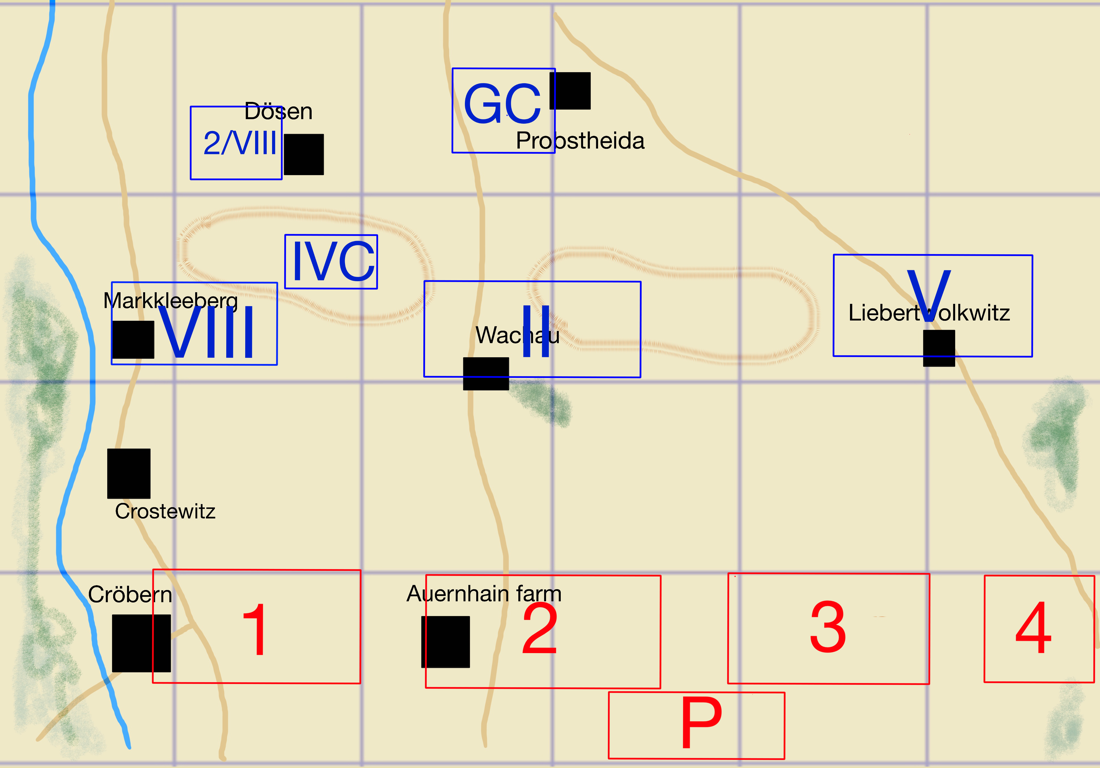


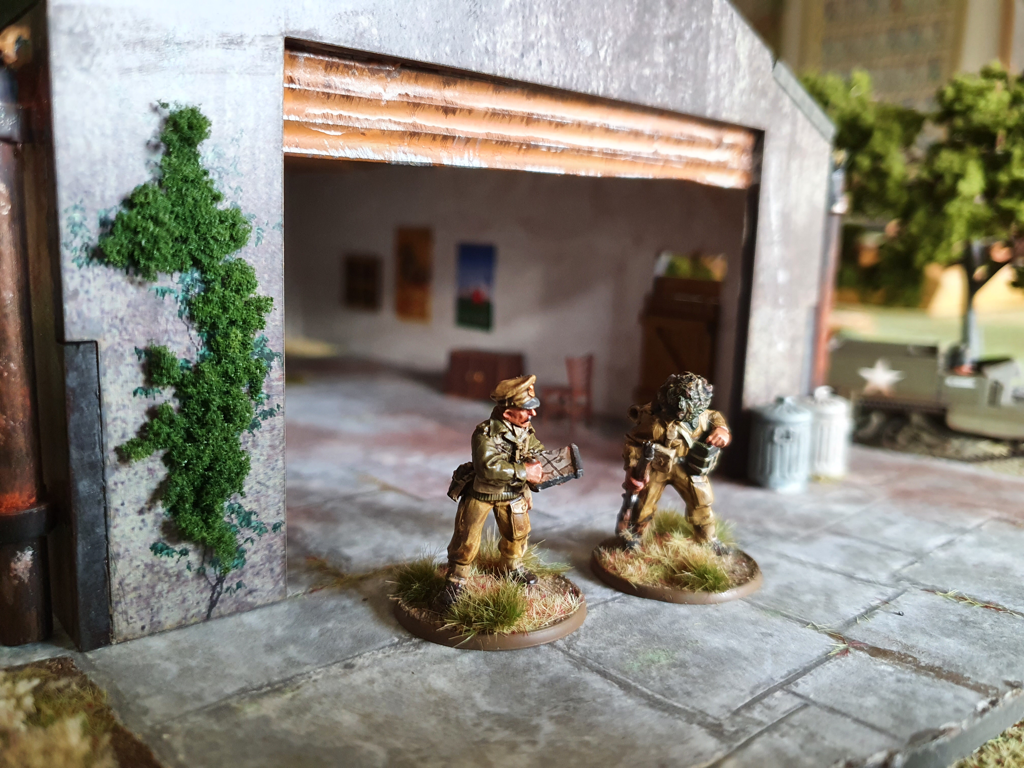




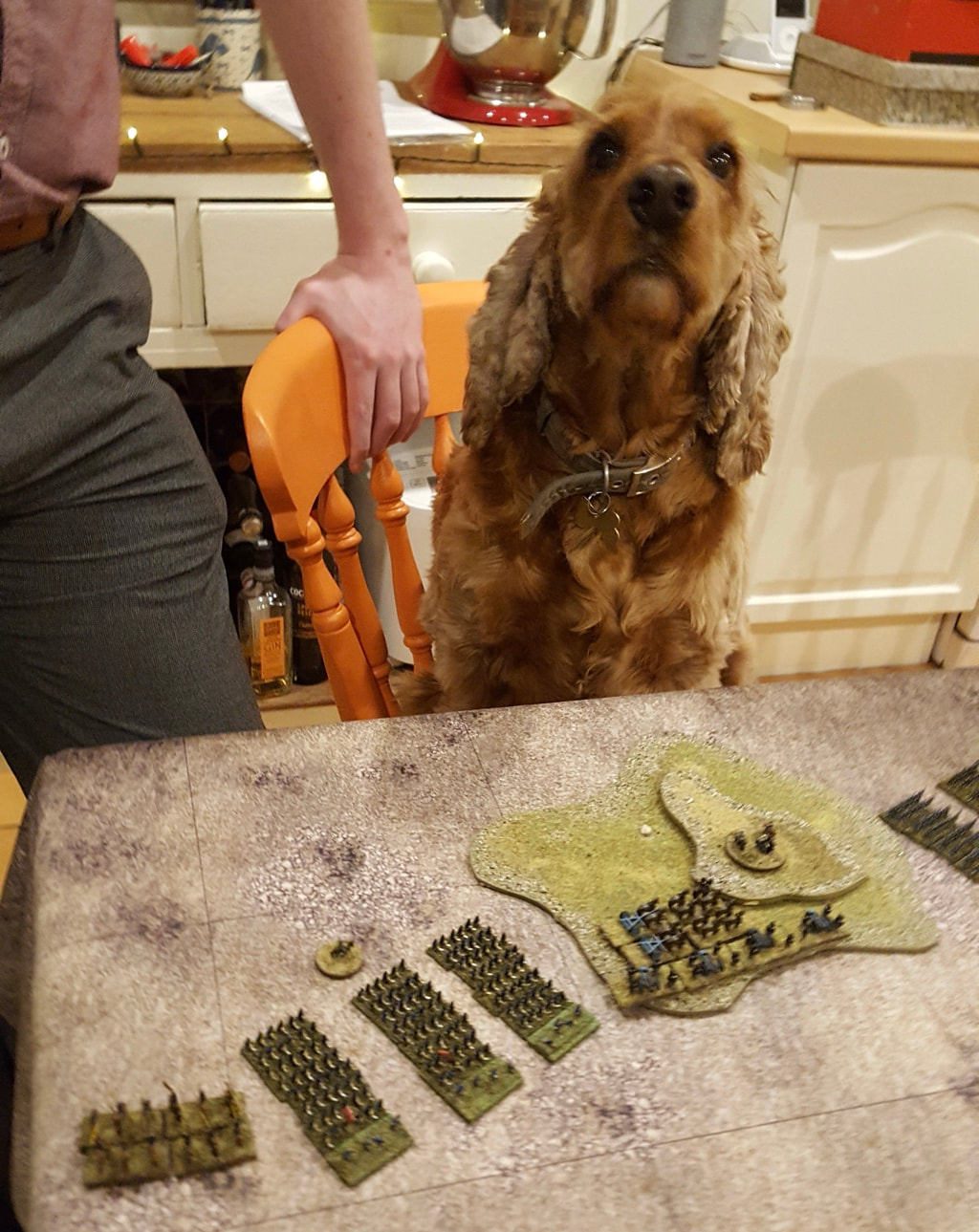


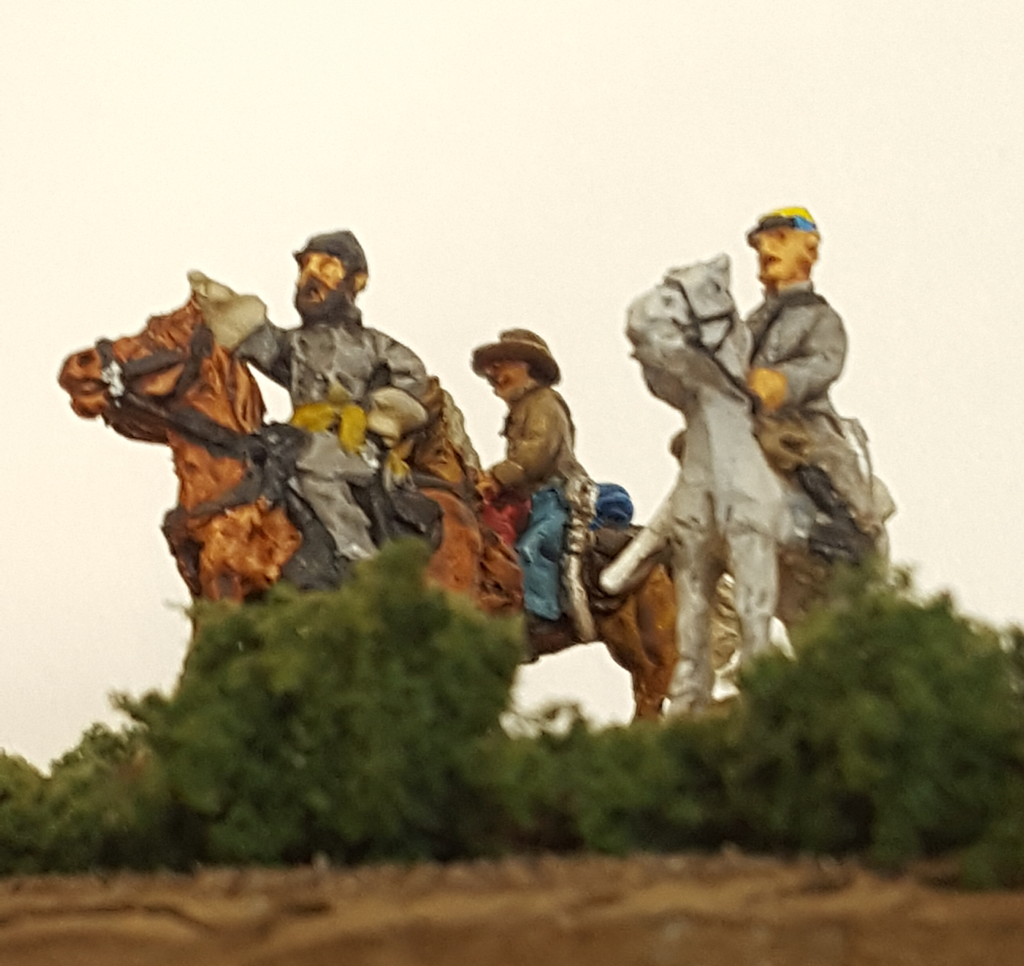

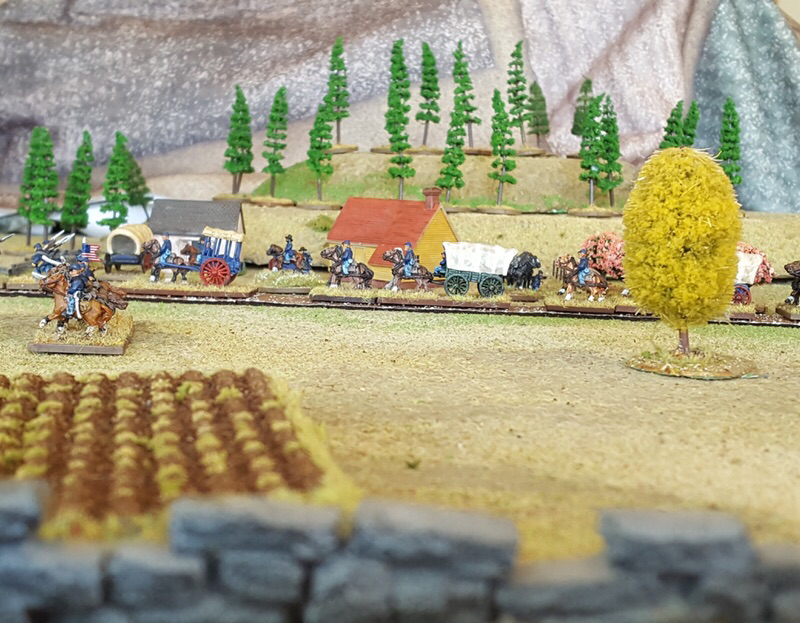




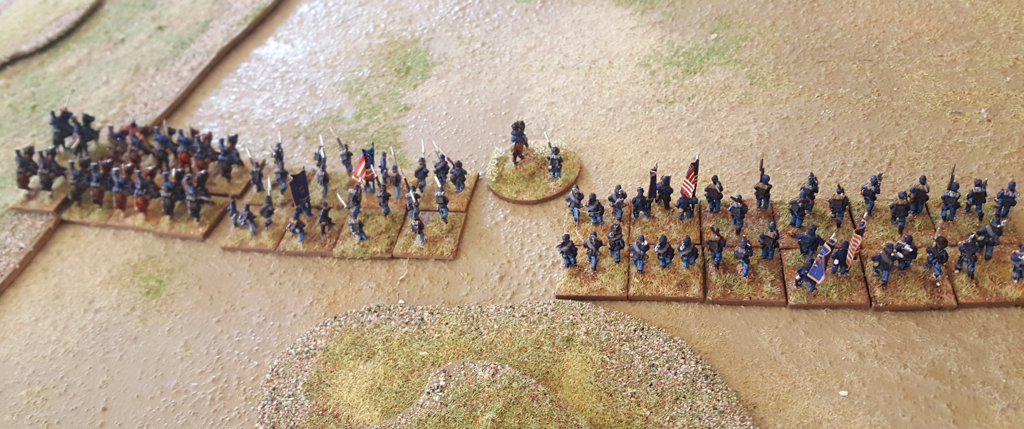


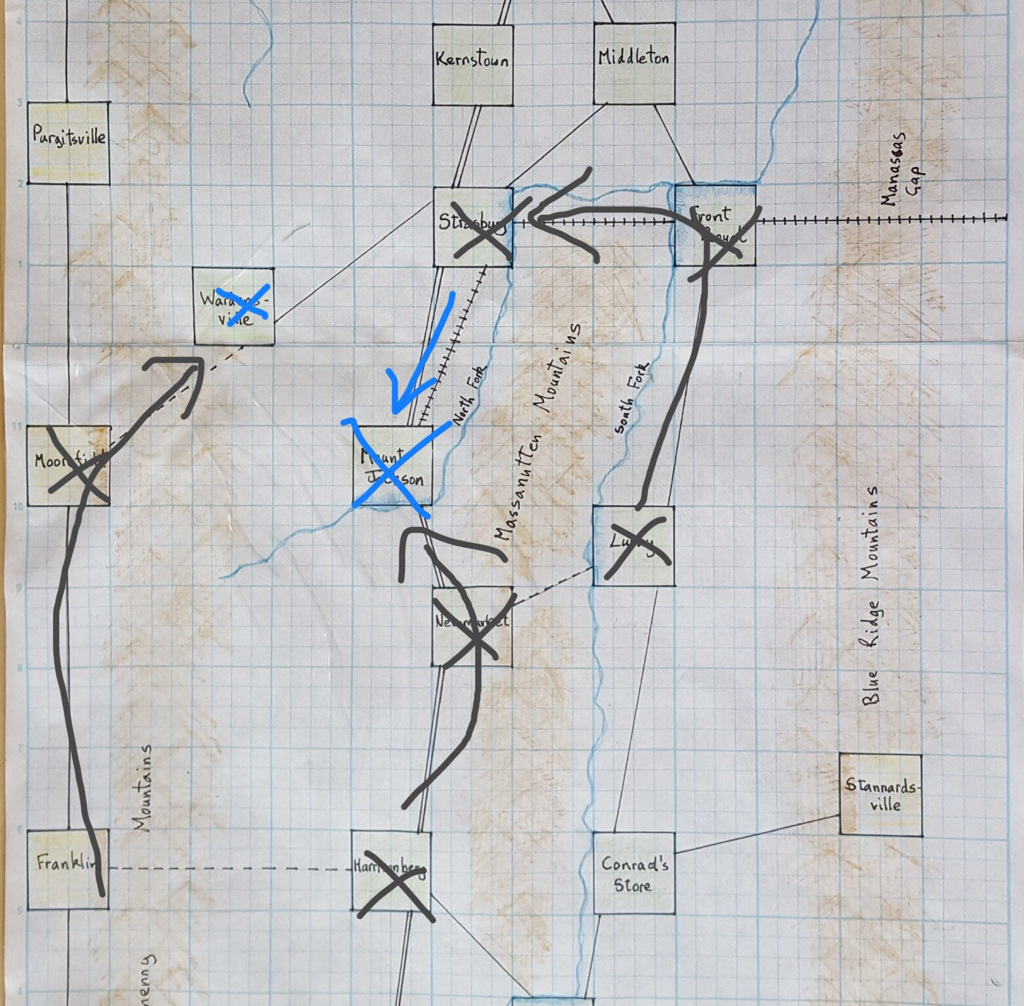
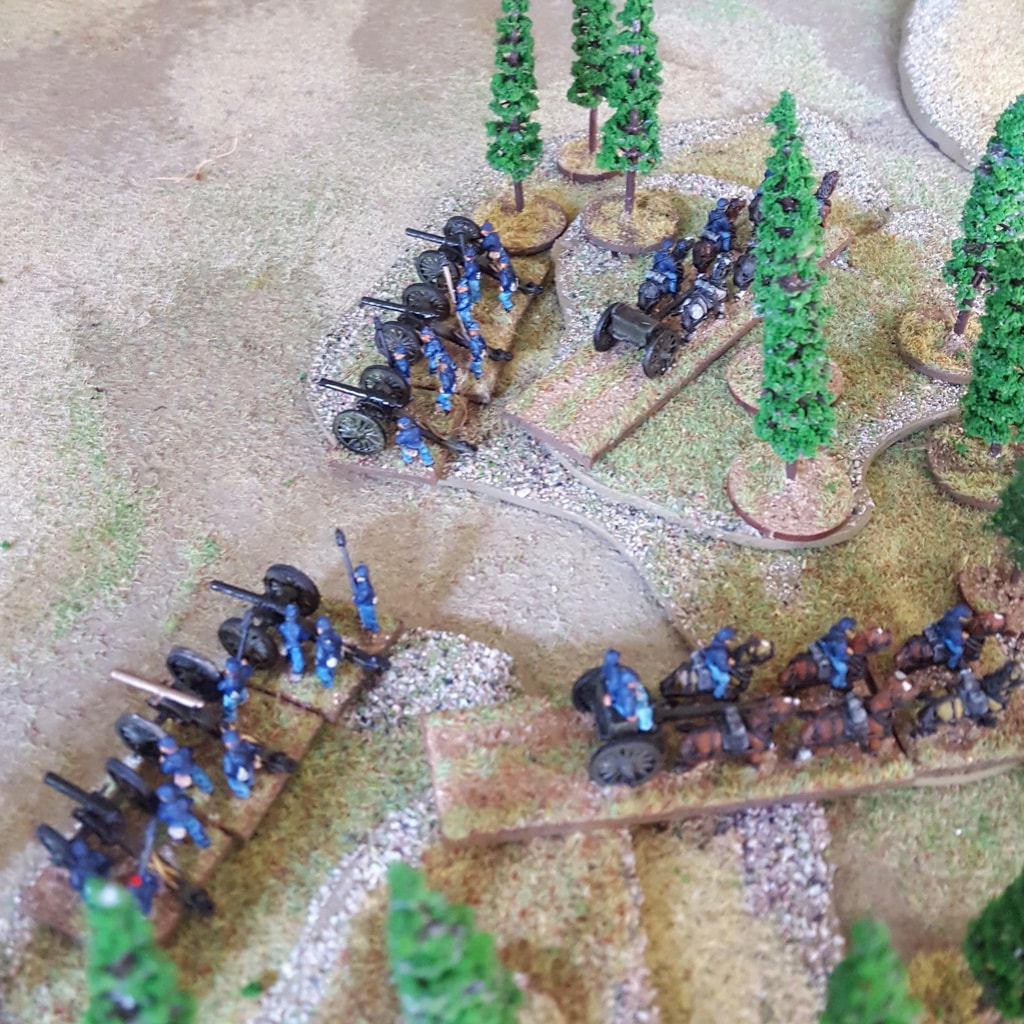
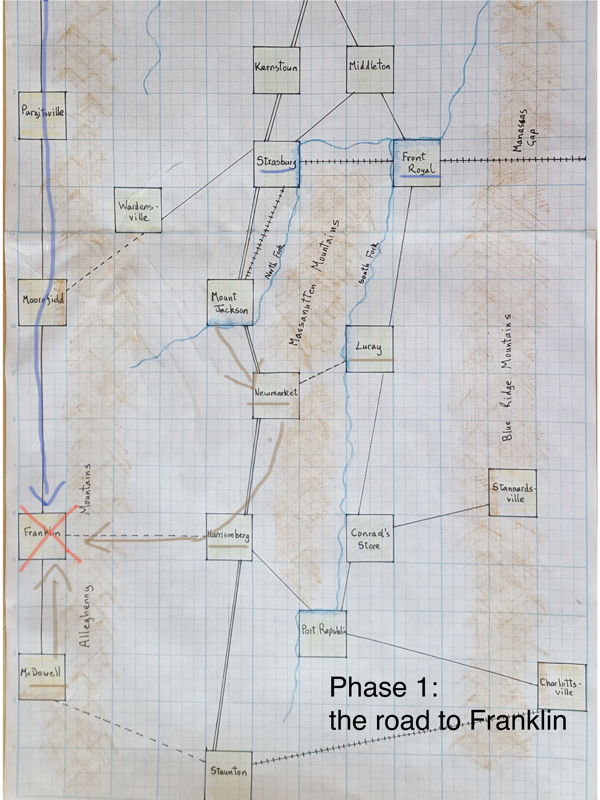
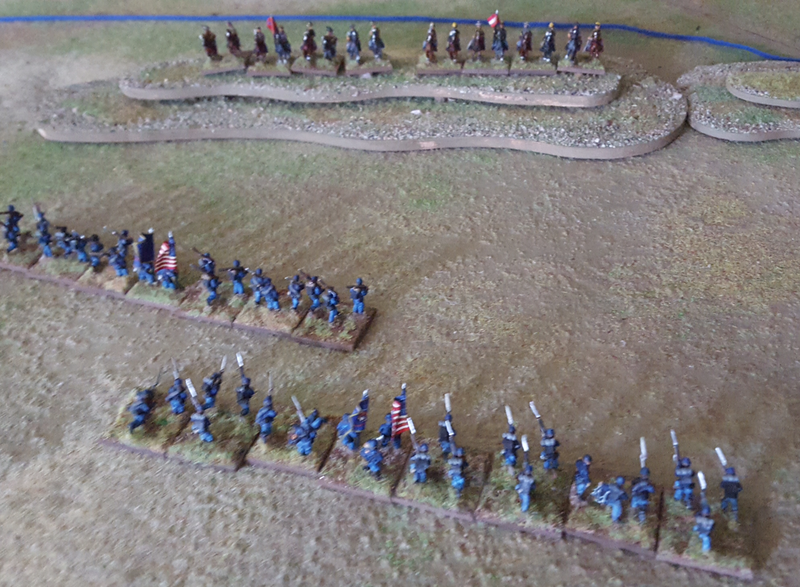
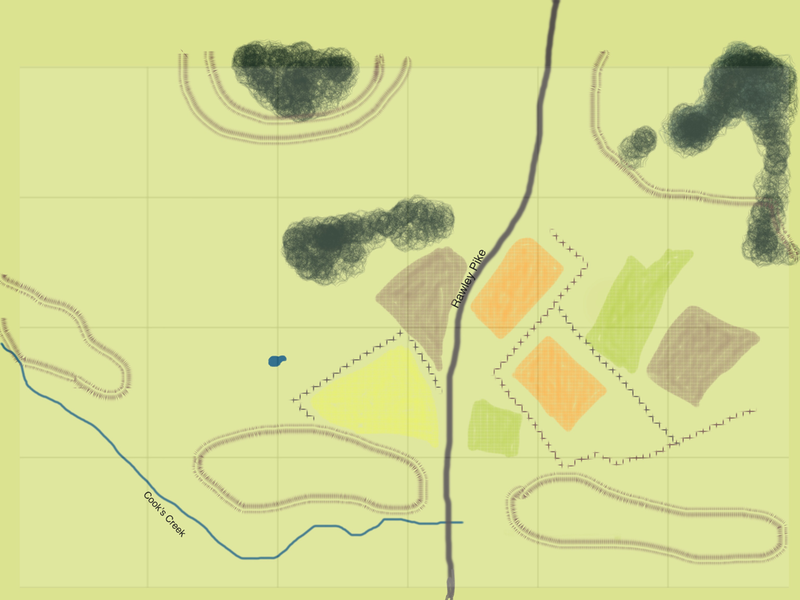

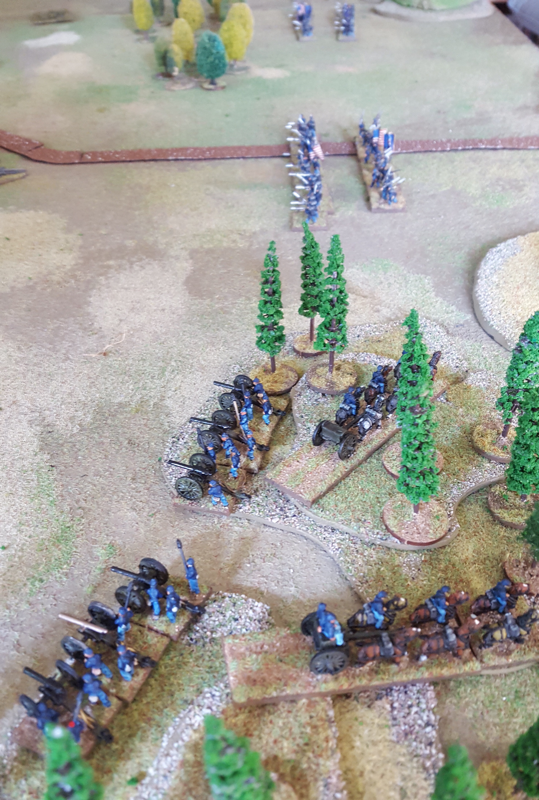


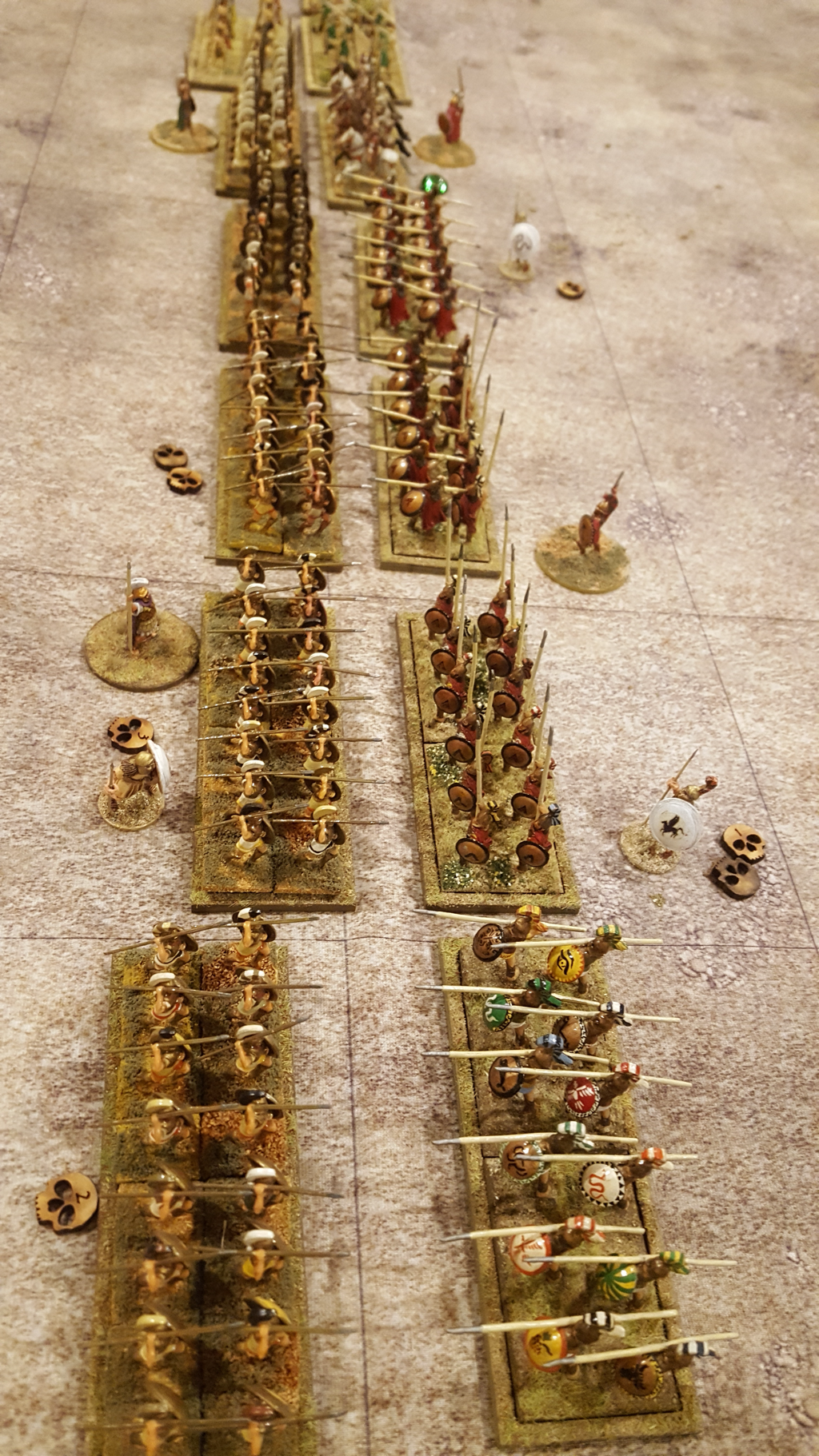

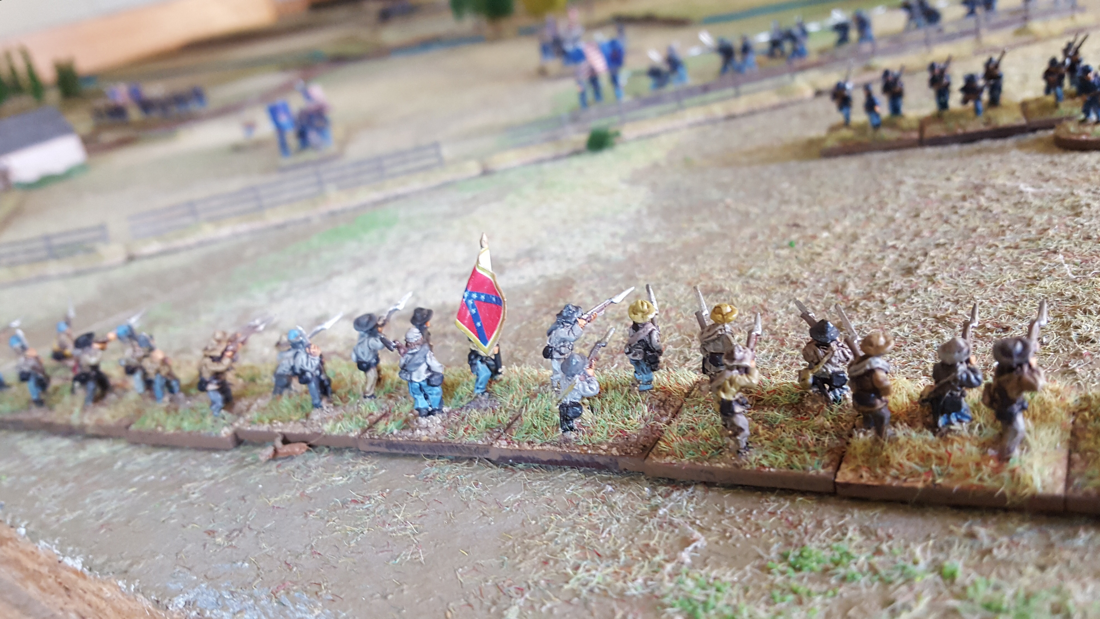


 RSS Feed
RSS Feed